COLOMBIA
COLOMBIA

Within the most important fortifications of "La Heroíca", the walls of Cartagena are the most recognized. It was a project that lasted almost two centuries and was completed in 1796 with the purpose of defending the city from the continuous pirate attacks it suffered. The historic center is surrounded by 11 km of these imposing stone walls, which are complemented by fortifications and bastions, from which one can observe marvelous sunsets over the Caribbean coast of Colombia.
History of the Walls of Cartagena

It was built at the end of the 16th century for the defense of the city. Construction began on September 8, 1614, after the attack by the legendary Sir Francis Drake and by order of King Philip III. The Italian architect, Carlos de Roda Antonelli, was in charge of the first stage of construction, which took 15 years, during which 15 bastions were raised with clear Italian-style influence. Then, in 1608, Cristóbal de Roda took over, fortifying almost the entire part of the city facing the open sea.
While this fortress was being built, the city experienced constant pirate invasions. Thus, the defense was complemented by the imposing San Felipe Castle, and a set of underwater breakwaters located on the island of Tierrabomba.
Since 1631, Francisco de Murga fortified the entire neighborhood that today enchants travelers from all over the world, the Getsemaní neighborhood. Additionally, later submarine boxes were built, forming a breakwater in front of the walls destroyed by the sea and in the section between Punta Icacos and Tierrabomba by Antonio de Arévalo, to prevent ships from passing through Boca Grande.
Two centuries passed, two centuries, for this majestic military structure to be finished. By 1796, the walls protecting the Historic Center of Cartagena were completed, which since the founding of Cartagena de Indias in 1533, and throughout the entire Spanish colonial period, was one of the most important ports in America. Its bay was protected by the Spanish military, forts, and walls, and its proximity to the city of Panama, another important Spanish port, made it a key fortress.
You may be interested in: Discover the best beaches of Cartagena
The Walls: UNESCO World Heritage Site

It is the most preserved and complete fortification in South America, and one of the best walls of walled cities in the world. Walk the 11 kilometers of the preserved wall belt, one of the most important attractions of Cartagena, declared a World Cultural Heritage site, an invaluable treasure that has not only withstood the attacks of invaders, time, and nature.
Built to keep enemies away, today the Walls are a symbol of Cartagena, inviting travelers to enter a city full of history and unique details.
How old are the Walls of Cartagena?
By 2020, the preserved Walls of Cartagena celebrate 406 years of existence. These walls have witnessed various struggles and the evolution of Cartagena, which is recognized as "La Heroíca". It is a jewel of architecture and military engineering, a very well-preserved historical piece that we can still explore and enjoy when visiting this beautiful Colombian city.
How to get to the walled belt of Cartagena?
The walls of Cartagena de Indias are located in the Historic Center, in the walled city. It is a 15-minute drive from Rafael Núñez International Airport if you are arriving from abroad or another city. If arriving by land, it is a 45-minute drive from Cartagena's Transportation Terminal. Once you arrive, enjoy a tour of the wall and the streets of the walled city and discover the history of the colonial city.
You may be interested in: Travel back in time by exploring colonial Cartagena
Eat ceviche in front of the clock tower, dance champeta and other music genres in the incredible bars inside and outside the Getsemaní neighborhood, and witness beautiful sunsets from the Wall.
What do our visitors say?
More activities in Cartagena de Indias
Each of the country's regions offers a different rhythm so you can do what you like most. With adventure tourism, numerous cultural activities and excellent gastronomy, we have everything to make your trip an unforgettable experience.

























